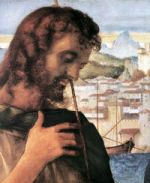Subscribe for free today!
Get newsletters with the latest content, and access to exclusive ebooks and podcast episodes.
Already subscribed? Log in to stop seeing invitations to subscribe.
St. Bernardino Fostered Holy Name Devotion
A recently acquired rare engraving of St. Bernardino of Siena (1370-1444), on display at the National Gallery of Art in Washington, affords a good occasion to reflect on the Holy Name of Jesus. The engraving, the best surviving example of the first realistic portrait in print form, shows the saint holding the monogram of Christ as he often did during his popular sermons.
St. Bernardino would hold up for veneration the monogram of Christ's Name — the letters "IHS" — surrounded by rays. This ancient monogram is a Latin form of the Greek monograms for Iesous Christos, "IH XP" and "IC XC." It became even more popular after St. Bernardino persuaded a playing card maker in Bologna whose business had been ruined because of the saint's preaching against gambling — to make holy cards depicting it instead of making his usual fare.
The engraving based on Bernardino's death mask was made in Germany by an anonymous artist shortly after 1450 when the saint was canonized. It shows a large crucifix (mandated by Pope Martin V when he approved Bernardino's use of the monogram disk) and a dove flying toward the saint's mouth, presumably indicating the Holy Spirit inspiring him. The child at his feet might be a soul, while the tiaras symbolize the approval of three popes.
An engraving is produced by incising lines with a tool called a burin into a copper plate. The plate is then inked and wiped so that the ink only remains in the incised lines. When the inked plate is put through a press, every impression that results is an original work of art. The process, requiring great skill, made it possible for people of modest means to own original art.
The Holy Name of Jesus
January is traditionally the month of the Holy Name of Jesus, and Jan. 3 has been restored by Pope John Paul II as the feast of the Holy Name. This feast, still celebrated by the Franciscan order on Jan. 14, commemorates the circumcision of Christ, where he received the name Jesus, in Aramaic Yeshua, that was given by the angel Gabriel from God (Lk 1:31). It means the one who saves. When a Jewish child was circumcised, he was accepted as a son of Abraham and a full member of his family. The Christian practice of infant baptism was adapted from this Hebrew ritual.
We honor the Holy Name because of the command of Christ: that we should pray in His name. "Holy Father, protect them in Your Name that You have given Me" (Jn 17:11-12). As St. Paul wrote to the Philippians: "at the name of Jesus every knee should bend of those in heaven, on earth, and under the earth (Phil 2:10). By means of this devotion, we also make amends for improper use of the Holy Name. Honor to the Holy Name is the reason that devout Catholics bow their heads at the sound of "Jesus both inside and outside the liturgy.
One Catholic Web site, beautifully describing the Holy Name, observes that "As the name of each individual person embraces the totality of the person, the most Holy Name of Jesus also embraces the totality of the divinity. When we think of a person, we remember the name, and we visualize their image. Equally, when we think of Jesus, we remember His-name and we visualize the image of God in Jesus. 'For in Jesus the whole fullness of deity dwelled bodily' (Col 1:19, 2:9)."
St. Bernardino's Lasting Fame
By promoting the Holy Name devotion, St. Bernardino of Siena made people more aware of the individual personality. Although he refused all worldly honors, this charismatic Franciscan preacher is the very first canonized saint for whom we not only have an extensive record of his ideas, but we also know exactly what he looked like.
Bald and toothless, Bernardino is depicted wearing the beige Franciscan habit. In Washington's National Gallery of Art, his popularity is attested to by several beautiful paintings of the Italian Renaissance period that were once in churches. One early panel (c. 1460) pairing Bernardino holding the monogram disk with St. Anthony Abbot, is painted by Jacopo Bellini, the pioneering Venetian artist. In another panel, Vincenzo Foppa, a painter active in Milan before 1500, portrays the Franciscan friar holding an open book inscribed Pater manefestavi nomen (Father, I have manifested [Thy] name) from John 17:5,6, words recited by St. Bernardino while he was dying. On the book's facing page is the monogram IHS.
This item 6318 digitally provided courtesy of CatholicCulture.org






